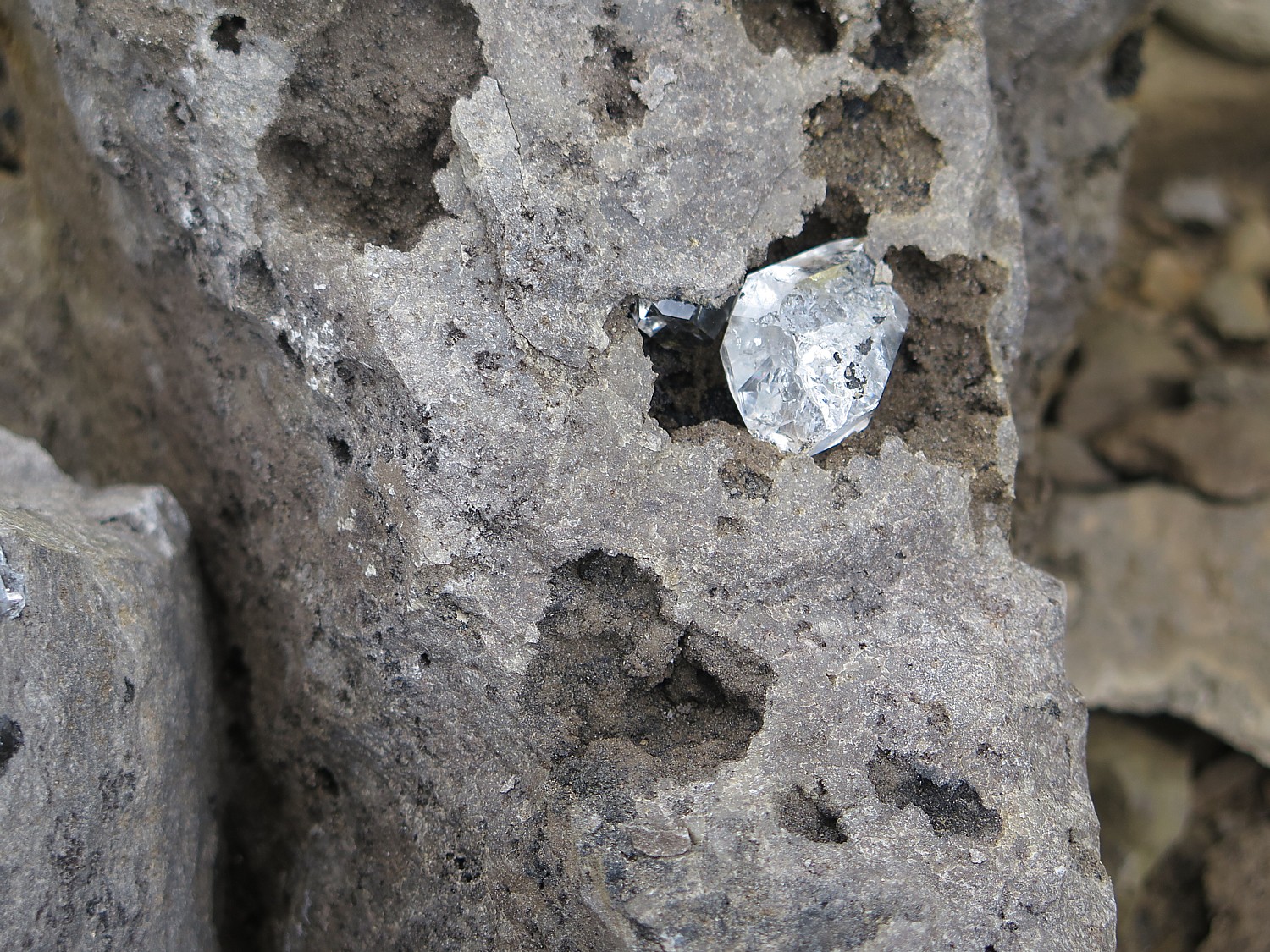
There I am, swinging a small sledgehammer, quarrying for diamonds – Herkimer Diamonds, that is, extraordinary quartz crystal nuggets that emerge (even pop right out) of their rocky prison with 18 facets, as if they had been cut by a jeweler.
You never know what you will find, what the next smashing, crushing blow will reveal and it is thrilling when you crack the rock to expose the diamond. A treasure hunt, to be sure. But it is also remarkably satisfying to be smashing rock.
This is just one of the – dare I say – unique attractions when you come to Herkimer Diamond Mines KOA, a true camping resort, in upstate New York. An altogether different experience – certainly, not your father’s camping experience.
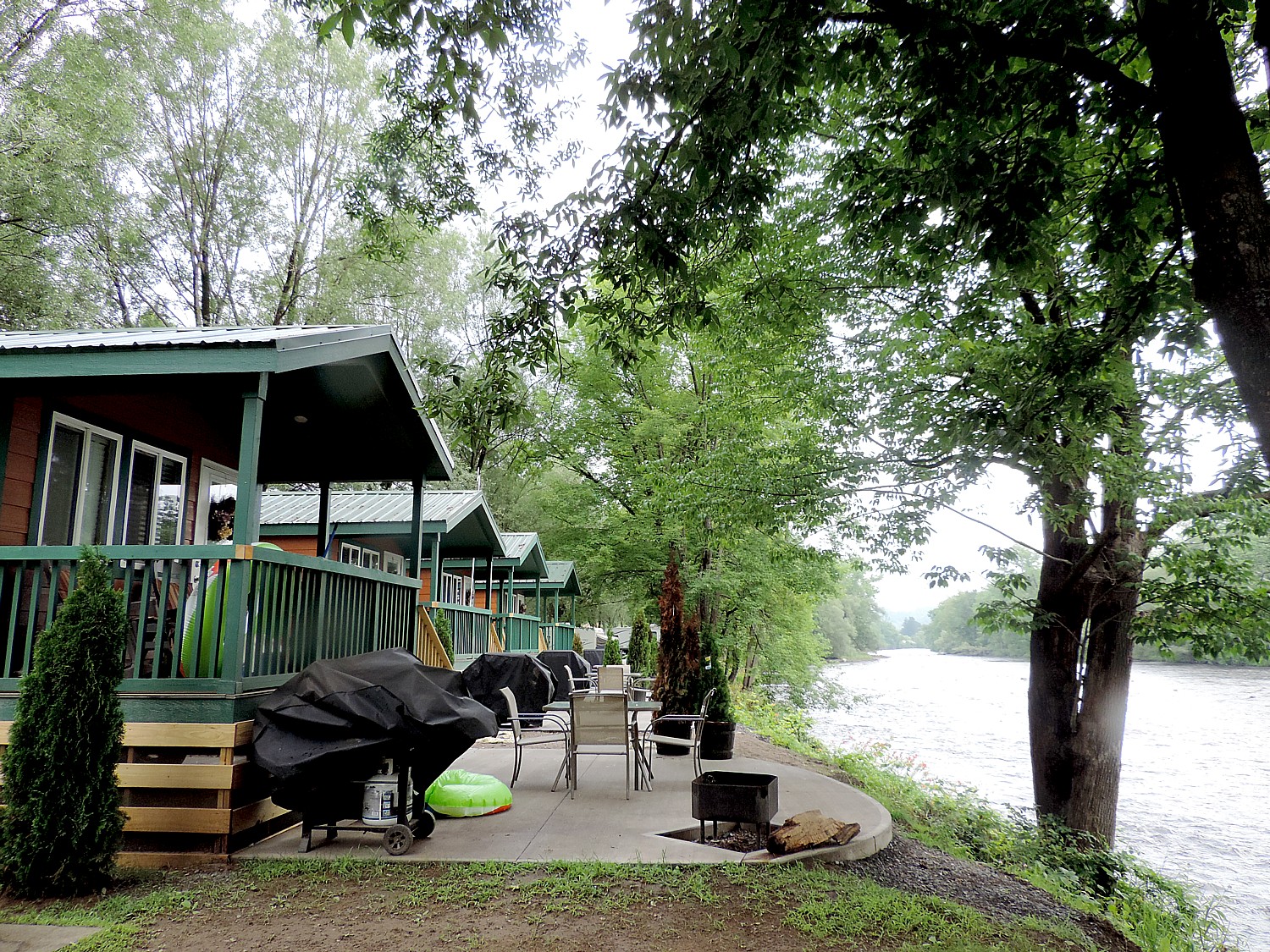
To begin with, I am in one of the Herkimer Diamond KOA’s new themed cabins, set right on a rushing creek, which campers use for tubing (a whole mile from beginning to end, for a 20-minute ride!), and others use for some of the best trout and bass fishing in New York.
Mine is called Randy’s, named for the triceratops skull that is on view in Herkimer Diamond Mines’ gems and fossil museum (yes, it has its own museum), and is themed for dinosaurs.
The first emotion I feel when I enter is sheer delight that manifests as an ear-to-ear smile when I see all the dinosaur accoutrements – including a two-foot high (plastic) raptor that whenever I see it in the corner of my eye, makes me jump. The bedding, shower curtain, wall hangings are all themed for dinosaurs, and it is complete fun (informative, also).
The cabin is outfitted with every creature comfort you could possibly want – a well equipped kitchenette, bath items, flat-screen TV, sofa in the living room, table with four chairs, air conditioning and heater, linens and towels – all cleverly laid out to maximize space. The porch has a rocking chair and there is even a patio, right beside the creek, with patio furniture, BBQ and firepit. And WiFi, which has become such an essential feature.
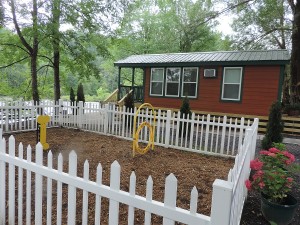
Other cabins and lodges are also themed: there is Caesar’s Place (Woof), which has its very own doggie-park; Another is themed for fossils and even has its own pit where you can dig to find your own fossils.
There are even more elaborate lodges (I really would have trouble choosing): one is themed for astronomy and actually has its own “planetarium” with a sophisticated, computer-operated telescope as well as photos taken from the Hubble telescope; another is Professor Gadget’s Robotics Lodge that features working robotic components (“to educate and entertain”) devised by Binghamton University grad students.
Then there are three lodges that operate on solar energy – just part of the initiative to demonstrate renewable energy and model eco-friendly living.
In another delightful socially-conscious and community-building initiative, there are 40 bins where they grow fresh vegetables, and campers are welcome to help themselves. There is also a Japanese garden which is a tribute to the victims of Japan’s tsunami.
There is so much about the Herkimer Diamond KOA that is special – and I haven’t even begun to describe the diamond mining, jewelry making. and Erie Canal cruising.
There is an atmosphere here – it’s true of camping in general, but there is something very special about this place.
To begin with, its Edutainment – that is, a healthy mixture of education (or actually, enrichment) with entertainment, that is woven into the architecture, the landscape and programming.
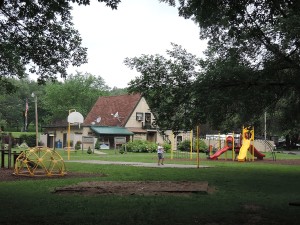
There are daily activities – jewelry making, science experiment (static electricity, make a volcano, make a balloon rocket), badminton, flag football, cray fishing, basketball, chess and checkers tournament, volleyball, dodgeball, water balloon toss, table tennis, scavenger hunt, relay races, hula hoop contest – as well as nightly movies (outside on nice evenings, under the pavilion when it rains), and gatherings around the firepit (S’mores on Saturday nights).
There is a huge playground area – separate playground equipment for youngest kids and older kids, and basketball court.
A volleyball court which is next to a gigantic firepit which is a gathering area (s’mores on Saturday nights); and a pavilion where there are games, a snack bar (ever try a breakfast pizza? It’s made with bacon and egg; and a Herkimer Diamond pizza for evening).
There is a gorgeous swimming pool (next year, the plan is to have it solar heated).
If you forgot your tube or fishing rod, you can buy these in the Herkimer Diamond KOA general store; in fact, probably everything you need, forgot, wish you brought, can be had there, so if you wanted to travel light, no problem.
And if you don’t feel like cooking, there is the Rock n’ Roll Cafe, as well as Crystal Chandelier Restaurant, a very pleasant pub-style restaurant located a short walk across the road from the campground (KOA guests get a discount and $9.95 nightly specials, 4579 State Rt. 28N,, 315-891-3366, crystalchandelier.net).
You can easily fill out a two or three-day getaway with just the activities right at the resort: directly across the tiny road (Rte 28), from the camping resort is the Herkimer Diamond Mine – an attraction that brings people from far and wide, including many who come back time and again (more on that to come). There is mile-long tubing along the West Canada Creek, which also affords some of the best trout and bass fishing in New York State.
Just about five miles away – bikeable on the bike lane on Rte 28 – is the uniquely appealing Erie Canal, where you can enjoy Gems Along the Mohawk (owned by the Herkimer Diamond KOA people) a combination visitor center, specialty shops showcasing regional artisans and artists, Waterfront Grille for dining, and a marvelous 90-minute narrated Erie Canal Cruise which climaxes with the experience of going through Lock 18, as well as biking along the Erie Canal. Not to mention that Cooperstown is about 30-minutes drive away.
Mining for Diamonds!
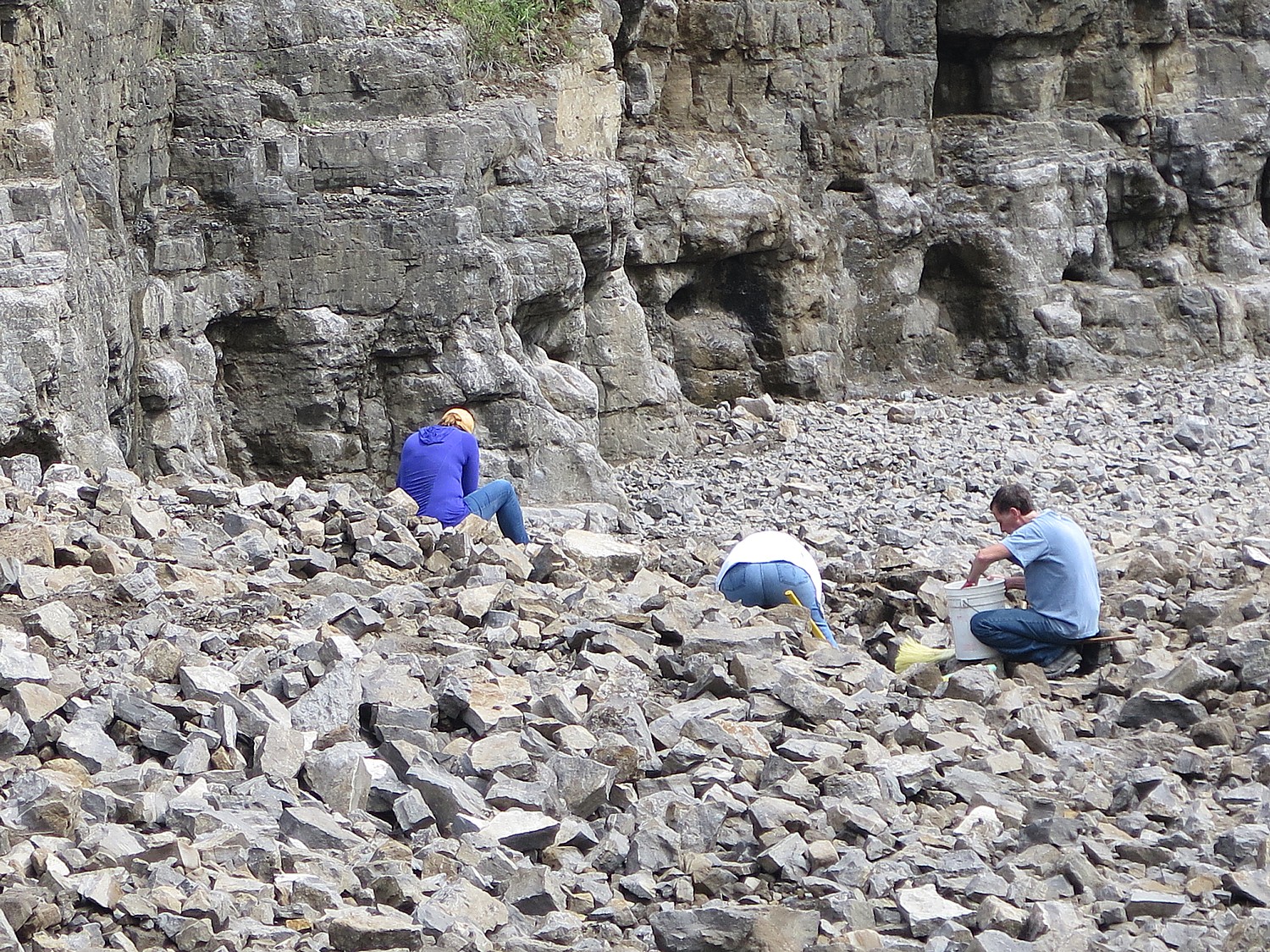
Mining for the Herkimer diamonds isn’t a fantastical thing – it is more unlikely that you will leave without finding one than it is to find one. And there are many people who come and merely gather diamonds from the ground, without even swinging a hammer.
The kind of mining we get to do is “quarry” mining, rather than going into a cave. An outcrop of rock of this giant crystal-laden mountain has been exposed, and the idea is to basically look for rocks with black holes or a black vein – sometimes pulling down rock using crowbars and chisels, and 6 to 20 lb. sledge hammers. Then whacking at the pieces of rock with a 2 or 3 lb. crack hammer.
Jordan, Herkimer’s resident miner (your image would be of a grizzled, fossilized old man, but Jordan is a young strapping fellow who grew up nearby but learned his mining skills on the job), guides me in what to look for: a dark pocked hole in a rock that makes it a good candidate for housing a diamond. Then he shows me how to set it down on flat ground and whack across a line (being careful not to smash your hand, finger or foot). Sometimes, you don’t want to release the diamond, but let it show itself off in the rock.
Most Herkimer Diamonds, no matter how small, have 18 facets – all you do is wash off the mud and there you have it: a jewel.
Jordan tells me that each Herkimer diamond stone is unique. “To a collector, a certain stone ‘speaks to him’ because of its shape, inclusion, anthraxolite (ancient carbon) inside, presence of a water bubble, or another distinctive feature like a negative crystal (another stone) inside.”
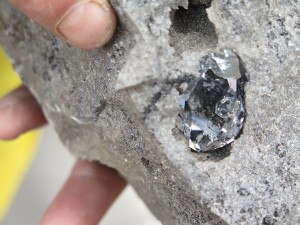
Often you see the rock not with a single stone, but with “druzy” – thousands, even millions of sparkling Herkimers, that form a vein or fill one of those black holes. “We don’t know why – perhaps it is a phase of growth,” Jordan tells me. Rocks with druzy can be even more valuable because of how beautiful and unusual they are.
He says that often, the stone is even more valuable when it is kept in the rock, where the black-hole background enhances the visual display – makes it “pop” (you have to put felt on the bottom or the rock will ruin wood or glass).
I find a fairly large Herkimer diamond, which Jordan estimates to be valued at $25.
The most perfect crystals are usually less than half-inch long, but occasionally much larger crystals are found. Crystals are also common that are intertwined or clustered, with perfect crystals attached to the backs of larger ones. And you can bring your day’s find into the shop for an appraisal. (The most valuable stone a tourist found was valued at $2000).
You can watch a video in the museum which explains the process.
(The admission pass, $11/adult, $1 less for KOA campers and veterans, $9/ages 5-12 – includes all day prospecting, use of rock hammer, all day museum entrance, zip lock bags, mining information. You should bring protective eye wear and closed-toed shoes, though they sell goggles. Some people bring their own chairs, umbrellas, chisels, screens. and when you get hungry, you can visit the Rocks n’ Roll Cafe, right by the quarry.)
Polished by Mother Nature
It doesn’t matter to me that the Herkimer diamonds are not actually diamonds – they are marvels in their own right in that they literally pop out of the dolomite rock that holds them, coming out polished and faceted by Mother Nature. (And many attach healing powers to them.)
They look like actual diamonds, but in actuality, they are “doubly terminated” quartz crystals. They have a hardness of 7.5, comparable to emeralds and aquamarines, whereas diamonds, which are formed from carbon, have a hardness of 10 (one of the hardest substance known to man). Most interestingly, by quirk of how the earth formed, they are found mainly in Herkimer County and the Mohawk Valley of New York.
The dolomite bedrock in which the crystals are found – a sedimentary carbonate rock, closely related to limestone – began forming 500 million years ago in a shallow Cambrian sea on the southern shores of what became the Adirondack Mountains. The limy sediments (calcium magnesium carbonate) which had slowly accumulated beneath the sea’s saltwater were gradually compacted under the weight of thousands of feet of sediment, forming the rock strata Dolostones (interestingly, it is also in this layer of Early Ordivician rock that the first evidence of marine life can be found).
It is believed that while still beneath the sea, water seeped through the pores of the rock, often creating “vugs” by dissolving part of the rock. Millions of years later, water rich with silica filled these vugs and eventually evaporated or drained away, leaving the silica which had grown by precipitation to form the quartz crystals.
One theory that explains the source of the silica material is that hundreds of millions of years ago, there were micro-sized simple-cell sea organisms that lived in colonies and secreted silica in glass-like geometrical shapes, and that they were trapped under the sediments.
A series of evolutionary geographical events continued through the Ice Age – the Pleistocene Epoch. A giant continental ice sheet covered the region. Rushing waters caused by the melting glacier eroded away thousands of feet of sedimentary rock, eventually uncovering the dolomite rock layer.
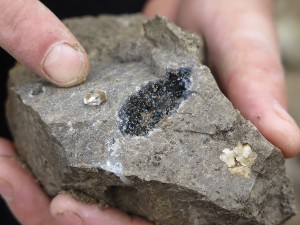
What is remarkable about the Herkimer diamonds is that most have 18 facets – six triangular faces form the termination points on each end of the crystal – regardless of how small they are. These are separated by a group of six square or rectangular faces that form a diamond shape, with such precision that it would be hard to reproduce by hand.
“Most limestone doesn’t throw quartz crystal like here,” Jordan tells me.
A “curiosity” of some Herkimer Diamonds is that many of the crystals have liquid trapped inside, which can be seen with the naked eye because of the clarity.
The liquid inside the inclusion is mostly saltwater, confirming that seawater was present when they were forming. Many of the liquid inclusions have bubbles which float about in the liquid – some are carbon dioxide gas, but most are water vapor.
Some Herkimer Diamonds have solid inclusions – most commonly a coal-like substance called “anthraxolite,” which give the pockets a solid black appearance. The anthraxolite could be the result of decomposition of plant life that inhabited the sediments.
Another theory is offered to explain the source of the silica material – that hundreds of millions of years ago, there were micro-sized simple-cell sea organisms that lived in colonies and secreted silica in glass-like geometrical shapes, and that they were trapped under the sediments.
As for the discovery of the Herkimer diamonds: Local lore has it that two Revolutionary War soldiers happened on the diamonds and believed they were real. Their commanding officer, General Herkimer (who went on to become a genuine hero of the Revolutionary War), was said to want to use the diamonds to help finance the war, but that when the minerals were assayed, they were found not to be actual diamonds.
“General Herkimer is legend in the valley,” Dr. Renee Scialdo Shevat, who owns the property, tells me later. “They named the county, the village for him. He led troops to Battle of Oriskany – a turning point for the Revolution.” (He mustered 800 locals for a militia to save Fort Stanwix which was being blockaded by British, and when the British retreated, that gave the patriots their first victory.)
“But it is a myth that Herkimer financed artillery with Herkimer diamonds. The Native Americans were first to find the diamonds. The Mohawk Valley was called the land of crystal. Iroquois arrowheads have been found that used Herkimer diamonds.”
Awareness of the Herkimer diamonds goes back to at least 1819 but James Hadley is credited with being the first to bring the diamonds to public attention, in 1823. Prospectors were blasting the hard dolomite rock earlier than 1879. But what really exposed the diamonds was cutting the road for Route 28 which passes directly in front of the Herkimer Diamond Mines.

The Herkimer Diamond Mines was first opened to the public in 1955 for prospecting by the farmer who owned the property. Eventually the property was sold to investors headed by Van Atty, who developed the mine, the rock shop and a public campground for the prospectors. In 1981, Rena and Rudy Scialdo purchased the property, today, it is owned and operated by their daughter, Dr. Renee Scialdo Shevat.
Dr. Shevat, who has a PhD in finance and strategic, took over the operation in 1997 and really boosted the Diamond Mines as an attraction and the Herkimer diamonds in jewelry, and has carefully guarded against over-saturating the market. The mountain that is rich in Herkimer diamonds spans 300 acres, but in all these years, they have only opened 6 acres for prospecting.
As many as 500 people a day from all around the world come here to prospect.
People who aren’t physically inclined to smash rocks with a hammer can do very well just hunting for the Herkimer diamonds on the ground – Dr. Shevat relates how a 98-year old woman found $400 worth of diamonds loose in the soil.
If quarrying isn’t your thing, you can do sluicing – you can purchase a bag and do like the California gold miners, and run water over a sieve to find your treasure – which has its own Zen quality to it. You can purchase a bag that has Herkimer diamonds, or a bag that has various gemstones, or a bag that contains fossils (these are $11), or a “megabag” (it is giant), that has all three ($29).
Ambitious interns Blair and Josh, who are student teachers have produced a guide to what you find and are on hang to help people not just identify their finds, but to learn about what they are.
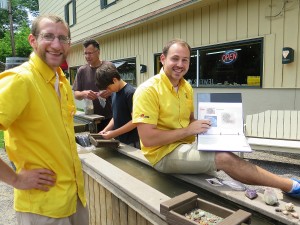
I did the mixed bag – and yes indeed, there were the Herkimer diamonds, nice chunks of amethyst, gemstones and fossils galore which Josh and Blair helped me identify: a blue stone (sodalite), rose quartz, a fossil with the imprint of a sea clam; petrified wood; agate; ammonite; ammulite (which they tell me could grow up to 3 feet long, and like an octopus, pull water in the shell, and squirt it out to propel motion); sand shark teeth; a crinoid (which I am told, was a free-floating animal that went extinct 65 million years ago), and a piece of coral.
Yet another activity at the Herkimer Diamond Mine: you can even get your picture taken via drone.
And if you get hungry from all your mining, you can stop into the Rock & Rolls Cafe.
Jewelry Shop and Museum
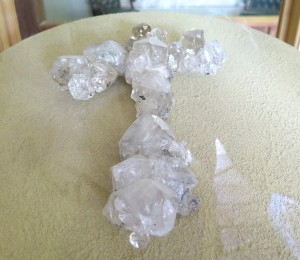
The Herkimer Jewelry Shop is an attraction in itself – not just items made from the Herkimer diamonds (which are actually sold on the Home Shopping Network, and similar shopping networks around the world, including Germany and Japan) – but gems collected and turned into jewelry by designers from around the world – Istanbul, Bali, Egypt, Rio, Hong Kong. It boasts being the largest jewelry, rock and gem store in the Northeast.
The second floor of the shop offers an extensive, really well-done museum with gemstones, rocks and minerals, as well as fossils, a Herkimer Diamond Hall of Fame, a Children’s reaching room, and an exhibit of the largest and finest cut Herkimer Diamonds.
One of the most remarkable exhibits is a massive cluster of Herkimer Diamonds, 17 x 12 inches (one of the largest ever found) in the shape of a cross, which Dr. Shevat tells me, was unearthed on September 11, 2001 at almost the exact time as the terror planes hit the Twin Towers in New York City. It seems to bolster the belief in such quartz crystals for their mystical properties.
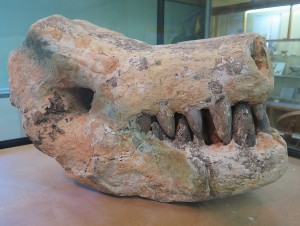
Another key attraction is Randy, a dinosaur skull from Madagascar (most likely a triceratops), found two years ago. Jordan points out that inside his mouth is another dinosaur bone, suggesting that the dinosaur died choking on its meal.
The building was originally an 1880 barn, and upstairs, you can see the original wood floor; and sit in chairs from the oldest movie theater in town to watch a video about prospecting the Herkimer Diamonds.
Herkimer Diamond KOA: An Edutaining Experience

In the morning, I wander around as this camping community comes to life – kids on bikes, parents walking dogs or pulling their kids , kids on the basketball court, people sitting by the creek with a cup of coffee, others sitting around a fire. A neighborhood that ebbs and flows daily, but a neighborhood, nonetheless.
There are all manner of RVs – some bigger than a bus – and I am always amazed at how people outfit them (one has its own bike rack, plastic bins all neatly organized, another has a TV and its own homecoming sign, “The Dennies”).
There are also many sites for tents.
“When I was 18, I might have tented, but not so much now,” Dr. Shevat tells me later when we go about the campground. “And people of all ages want to be able to charge their mobiles and computers and access WiFi. Kids like to tent but they want to charge cell phone,” so now they provide 30 amp connections at the tent sites.
There may be all these comforts added to the “camping” experience, but what is still true, is being outdoors. And together.
We see a steady stream of people returning from the creek with their tubes – you can float a mile, about 20 minutes worth, from one end of the resort to the other.
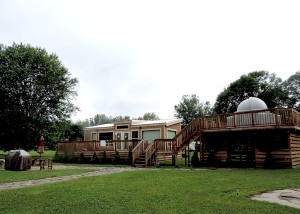
We meet people from all over the country – a family from West Texas, sitting around their campfire – and many who have been coming back year after year; the fellow who has rented the Astronomy Cabin (who turns out to be an astronomy hobbyist), who delightedly shows me the telescope, is part of a big group that comes to the campground every year for the Boilermaker Race that takes place in Utica.
Shevat, who earned a PhD in finance and strategic planning, was a vice president of a college with hopes of eventually becoming a college president, when, in 1997, she took over running the Herkimer Diamond KOA for her father, expecting it to be a temporary arrangement.
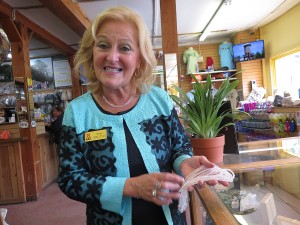
She went on to develop the four major business units – the campground, turning it into a camping resort with themed lodges; the Herkimer Diamond mine attraction; the retail shop; and now the Gems on the Mohawk complex with the Erie Canal Cruise. Her retail jewelry operation is global – selling on Home Shopping Networks around the world – and the Herkimer Diamonds have some novel uses, including being used in the making of vodka (Crystal Skull Vodka, with a bottle in shape of crystal skull from Indiana Jones, and 46 Peaks in Adirondacks, are filtered through Herkimer diamonds), and the Dalai Lama, she tells me, is purchasing Herkimer diamonds to decorate Buddhas.)
In the days of quartz watches, these diamonds were used for their precision with which they would release their pulse, and there is some research being done to see if there are new uses for the Herkimer crystals in telecommunications.
But she is an educator at heart, and interweaves “edutainment” in every aspect of the resort.
They offer two sessions of week-long science camps, accommodating 100 kids at a time (they had to turn away 26 for the first camp), where kids get to take part in activities like exploding volcano, dissecting a frog, building a robot, flying drones, and learning about geology, paleontology, gemology. (Activities for parents are organized, as well, such as trips to nearby Cooperstown.)
And there are weekend sessions for Boy Scouts and Girl Scouts to earn a Gemology badge.
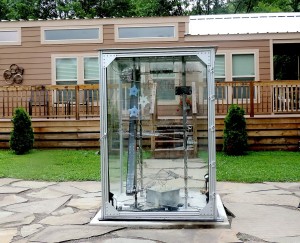
About inviting Binghamton University graduate students to help design the Robotics Lodge, she says, “What is unique about this project is that each student was allowed the freedom to design to their strengths, which they believed would be enjoyed by many campers. What better sense of accomplishment can one have when you build something unusual with high energy collegiate talent for campers to experience an all-inclusive scientific theme…The partnership with Binghamton University and campers, as consumer consultants, was very rewarding. And, yes, we would do it again with another scientific theme!”
Herkimer Diamond KOA was recognized in 2010 as KOA’s Kampground of the Year on the North American continent for its innovative lodgings and programming . Kampgrounds of America, with 485 locations in North America, is celebrating its 53rd Anniversary in 2015. (For more information and trip-planning tools, go to www.KOA.com.)
A stay at Herkimer Diamond KOA offers so much more to do, such as a canal boat ride with Lil’ Diamond III at the Herkimer Marina that takes you through a lock that lifts you up and down 20 feet on the Erie Canal (see next).
“Diamonds and the Erie Canal – two unique attractions,” Dr. Shevat tells me. “I want to be the centerpiece for dinner conversation: ‘Do you remember when we….?’”
The Herkimer Diamond KOA is open April through October (peak season rates apply July and August.) Weekends have special themes.
Herkimer Diamond KOA, 4626 State Route 28, Herkimer, NY 13350, 315-891-7355, E-mail: hdmkoa@ntcnet.com, www.herkimerdiamond.com; mining info at 315-717-0175, diamonds@ntcnet.com
Next: More to Do at Herkimer Diamond KOA: Gems Along the Mohawk, Eric Canal Cruise
_______________________________
© 2015 Travel Features Syndicate, a division of Workstyles, Inc. All rights reserved. Visit www.examiner.com/eclectic-travel-in-national/karen-rubin,www.examiner.com/eclectic-traveler-in-long-island/karen-rubin, www.examiner.com/international-travel-in-national/karen-rubin, goingplacesfarandnear.com and travelwritersmagazine.com/TravelFeaturesSyndicate/. Blogging at goingplacesnearandfar.wordpress.com and moralcompasstravel.info. Send comments or questions to FamTravLtr@aol.com. Tweet @TravelFeatures. ‘Like’ us at facebook.com/NewsPhotoFeatures.
